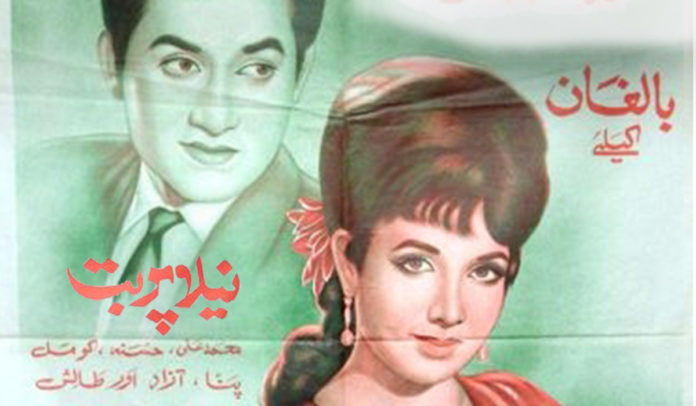The era of the 60s and the 70s is considered the golden era of Pakistani cinema. The country saw its film industry at its pinnacle; we had more than 1500 cinemas and a widespread mass culture of cinema where everyone loved films.
With the country witnessing its peak at both the economic and sociocultural fronts, the filmmakers had the luxury to experiment with varied themes and genres. Films were made on a diverse range of issues; from hippie culture to Palestine issue and on themes that artists in today’s era would rather hesitate to explore.
The case of Neela Parbat
One such film was Neela Parbat, which dealt with themes of sexuality, sensuality, incest and the fight with one’s inner demons nurtured by lust; something that’s considered extremely taboo even in our current setup.
The film starred Muhammad Ali, Agha Talish, Komal, and Husna. It tells the story of an old man (Talish) who secretly falls in love with his adopted daughter (Husna).
Muhammad Ali as Talish’s son plays a flirtatious guy who falls for two women (Husna & Komal) at the same time.
Talish, rather tactfully, betroths his son to another girl (Komal), so he could get closer to Husna. He also struggles with a lustrous attraction towards her, something that he and his son find incestuous. Meanwhile, Husna suffers from nightmares where a demon that she thinks is someone close to her, haunts her repeatedly.
The story unfolds as a confrontation between the father and his son when the latter eventually finds out the truth about his father, ultimately resulting in a bloody & tragic sequence that leaves the audience shattered.
What made Neela Parbat peculiar?
A lot of unique characteristics make Neela Parbat peculiar (even today).
Firstly, it was directed by Ahmad Bashir – a well-established journalist of his time – while it’s lyrics were written by giants of Urdu literature like Mumtaz Mufti and Hafeez Jhalandri (the man who wrote Pakistan’s national anthem).
On top of that, the film had innovative music (Piyarang Qadri) that used rare raags like Gaud Malahr. Additionally, it experimented with dance forms like Kathak and Bharat Natyam, instead of the usual dance forms used in the films, during those times.
Moving on to the film itself, it also had some steamy scenes between (a shirtless) Muhammad Ali and Komal; one shot on a beach and other in a room along with an equally hot lyric-less dance number.
Moreover, the film dared to focus on Talish as its protagonist and not on Muhammad Ali, the popular actor of that time. It was only the second film of the country that got an adult certificate after Zinda Laash (and the first non-horror film to get the A rating).
A case of missed opportunity
Despite all of this, the film could not do well because of its slow pace but mainly, because of being way ahead of its time.
It may not work even in today’s era mostly because our society (compared to the progressive 60s) has decayed further into a rather narrow-minded, shallow thinking group of people, to which anything thought and conceived out of the box is invariably heretic or dangerous.
While Neela Parbat may have failed to make its impact in its time, the era which it represents, undoubtedly succeeds in making us realize, how steep of a nosedive we have suffered, as a society, on intellectual, artistic and social fronts.
Neela Parbat can be found on YouTube and although the print is very bad, it is still worth a watch, especially if you want to get a feel of the glorious era that we are so unaware of.




